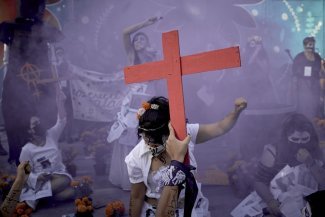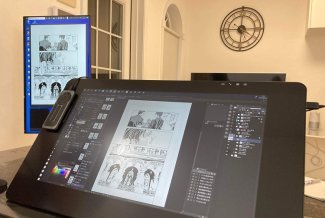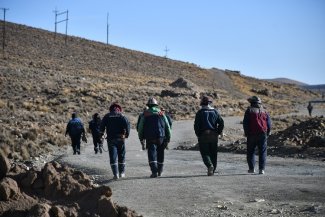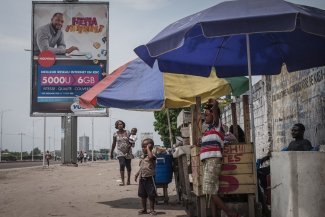In this photo from 18 October 2017, members of the press and EU representatives participate in a vigil in Brussels, Belgium, in memory of the Maltese journalist Daphne Caruana Galizia, who was murdered on 16 October of that same year. The journalist was investigating the so-called Panama Papers and corruption cases in her country.
In 2020, the number of journalists imprisoned worldwide for their reporting reached record levels: at least 274 (mainly in China and Turkey), of whom 34 were imprisoned for allegedly spreading ‘fake news’, compared to 31 in 2019. As in 2018 and 2019, most of the murders of journalists last year occurred in nations free of armed conflict, nominally at peace.
In democracies, this grim reality is encouraged by presidents and prime ministers who promote nationalist agendas and personal interests at the expense of their countries’ institutions and what until recently the vast majority of society recognised as ‘truths’.
In 2020, the press and journalists were identified by some leaders – among them the former US president Donald Trump and his counterparts, Brazil’s Jair Bolsonaro and Mexico’s Andrés Manuel López Obrador – as “enemies of the people”, “adversaries”, and even “worse than trash”. In these and many other countries, critical investigations were interpreted as “fake news” propagated by minorities against the peoples’ interests. The most concrete facts, the most irrefutable evidence, were systematically questioned by a handful of leaders.
We live, according to some, in the ‘post-truth era’. An era in which certain populist leaders communicate with the governed without mediation – or controls – and in which journalistic questions are frequently branded as lies.
A steady erosion that leaves a deadly mark
Throughout the world, “an environment has been created in which we have very little trust in the media, in the experts, in the facts. Many say we live in a post-truth world,” Courtney Radsch, advocacy director for the New York-based Committee to Protect Journalists (CPJ), tells Equal Times. “Right now all the epistemological foundations of our politics, our economy, are being challenged, and all this is happening in the middle of a pandemic.”
The concept of ‘post-truth’, defined as the public burial of ‘objective facts’ by an avalanche of “media appeals to emotion and personal belief”, has become popular since the 2017 to 2021 US president began his presidential campaign in 2015. In 2016, ‘post-truth’ was selected as the English word of the year by the Oxford University Dictionary. The notion encompasses a new dynamic, according to John Keane, a researcher at the University of Sydney, in which public debate is largely dominated by the repetition of short, simple messages despite their being refuted by demonstrable certainties.
It was in this context that the man defeated by Joe Biden was able to insist that he won his re-election comfortably at the ballot box in November 2020, despite losing by more than seven million votes to the Democrat candidate. The messages from the former president, all highly emotionally charged, using terms such as a “sacred landslide victory” stripped away from “great patriots”, convinced millions. For them, any journalist who refuted the message of the man who still occupied the White House was spreading fake news: a term that over the course of five years has become ubiquitous and has shaped the ‘post-truth era’.
The allegations (sometimes justified) that the media spread ‘fake news’ are as old as journalism itself. However, “we have not seen this rhetoric used in the same way before. This is a phenomenon that actually emerged with the presidency of Donald Trump, with his frequent use of the term [fake news] and has been adopted by numerous leaders in the world,” says Radsch. Never has a US president sought to discredit “on such a broad scale, to denigrate and delegitimise the press,” she adds, nor have so many leaders in the world so readily copied the model.
Politicians in many countries have described criticism in the media as ‘fake news’ with the aim, according to the United Nations Organisation for Education, Science and Culture (UNESCO), “of undermining uncomfortable truths and critical voices in the public debate”.
Furthermore, attacks on the press by those in power have in many cases become widespread: “it is no longer just about a particular mention that displeased a certain public official. It has become a criticism of and an aggressive and degrading discourse against the entire press,” Guilherme Canela de Souza Godoi, director of UNESCO’s division for freedom of expression, tells Equal Times.
This rhetoric has been reflected in the deadly attacks on journalists, as well as in the impunity that surrounds these crimes: 34 of the 50 journalists killed in 2020 took place in countries without armed conflict, according to Reporters Without Borders (RSF). Those countries, moreover, have been unable, or have lacked the political will, to solve most of these murders: CPJ’s Global Impunity Index now “includes more stable countries where criminal and political groups, politicians, business leaders, and other powerful actors resort to violence to silence critical and investigative journalists.” Mexico, Brazil, the Philippines, and Pakistan have the dubious honour of appearing right behind nations like Syria, Iraq, and Afghanistan.
Hence Mexico, which since 2004 has consistently been among the most deadly countries for journalists, topped the RSF list in 2020 with eight murders, followed by India and Pakistan (four each), then the Philippines and Honduras (with three and two, respectively). The level of impunity for the murder of journalists in Mexico exceeds 98 per cent, according to CPJ.
Coincidentally, with the probable exception of Pakistan, these countries are ruled by populist leaders who routinely target and harass the critical press. Populism, says UNESCO, is a “mode of political communication based on praise for the imagined unity and goodness of a majoritarian group, and condemnation of an allegedly elite or powerful community”. This trend “has infringed on media freedoms globally”.
Neither criticism from those in power nor populist speeches assassinate journalists directly. However, they do worsen the environment for journalism. “The surge of anti-media rhetoric in populist political discourse across regions has contributed to decreased public trust in journalists and media workers,” concludes UNESCO. “This has created a more hostile environment for journalists.”
‘Post-truth’ in social networks
Another novelty of the dynamics between those in power and the press is that “before social networks, the discourse of public authorities was mediated by journalists, who could provide a counterpoint to aggressive or false discourse,” according to Canela de Souza. “Social networks have put an end to this mediation.”
Perhaps the best example of direct communication between leaders and the governed was the last Republican president of the United States who in the first 33 months of his presidency produced 11,000 messages on Twitter, described as “a barrage of personal attacks, outrage and boasting.” His tweets had tangible consequences.
“With his near-daily denouncements of the press, the president has helped normalise abuses against journalists by ordinary people,” The Columbia Journalism Review concluded back in 2017. From May to October 2020, there were 120 arrests in addition to 222 physical attacks against journalists covering protests in the United States, of which more than 80 were perpetrated by protesters hostile to the work of the press, according to the US registry Press Freedom Tracker. At least 16 of the arrested US journalists face criminal charges, some of which carry prison terms.
Throughout the world, journalists who cover protests have themselves become targets for attack.
Between January 2015 and June 2020, UNESCO identified 125 protests in 65 countries in which journalists were attacked or detained, an unprecedented number. Another new development, according to RSF, was that in 2020 seven journalists were killed during demonstrations.
Hostility against the press also has consequences for that great pillar of democracy: public debate. Most Americans, for the first time in history, distrust the media. Fifty-six per cent think that “journalists and reporters deliberately try to mislead people,” according to public relations agency Edelman’s annual trust barometer.
This diminishing level of trust suggests that “post-truth politics” has gained ground. The dismissal of the work of the critical press as “fake news” has had an effect whose impact we have yet to find out.
In response, universities and the media have developed their own fact-checking tools. This process was launched at the beginning of the 21st century in the United States, but since then UNESCO found that a “second wave of fact-checking projects emerged following the global surge in so-called ‘fake news’”. As of the end of 2017, there were 137 fact-checking projects in 51 countries, such as Africa Check (South Africa, Senegal, Nigeria and Kenya), Chequeado (Argentina), Les Décodeurs (France), Faktisk (Norway) and Full Fact (UK).
The intention of these initiatives is to counteract attacks by governments on the press, “the consequence of which is diminishing trust in the important role of journalism to hold authorities to account,” says Canela de Souza.
Despite all the fact-checking efforts, the frame of reference used to discredit the press is already available to both world leaders and ordinary people, Radsch warns. The term ‘fake news’ is used to dismiss any information which you simply do not agree with. “I don’t see that changing anytime soon just because Donald Trump is no longer president,” she says. “That mentality has already deeply permeated politics and the public around the world.”










